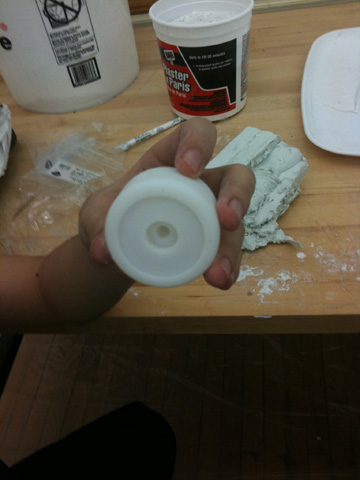



Straight Connectors
Design Process
In order to connect the pipes, a series of straight connectors were proposed to tie the pipes together. A number of pipe connectors were proposed, such as a keyway system, a clamp system, and barbed tube fittings. We decided on using a keyway system, as it would be the easiest to manufacture, and it would be quick and easy for a child to operate.
The dimensions of the connector were determined by the tube size we ordered, and the available materials. The material was chosen as PVC, because it was cheap and easy to work with. We chose to make the connectors using the milling machine, as the application need not be perfectly exact, and could be made fairly quickly on a mill.
Manufacturing Process
The PVC pipe was first cut to size with the band saw.
Due to the nature of the part, the vertical channels needed to be centered on the radius. In order to do that, we first placed the part in a collet, and then placed the collet in a rectangular shaped block of metal. Then one of the vertical channels, and half the horizontal channel would be milled. Then the block of metal would be turned, so the part would be turned 90 degrees, and the rest of the horizontal channel and the second vertical channel would be milled.
The key on the tubing was made by drilling a hole in the tubing, and then fitting a screw and a nut through the hole. Initially the screw didn’t fit through the channel, so the channel was widened using a file.







Design Flaws
Initially, the part wasn’t designed to use a collet, as we didn’t think about the vertical channels needing to be centered radially.
Also, the material properties of the tubing weren’t what we expected. The tubing meant to fit in the straight connectors was much more flexible than we expected, so we ended up substituting much thinner tubing into the connectors.
Angled Connectors
Design Process
In addition to the straight connectors, we decided we should have angled connectors that would allow kids to build at different angles than those achievable with just a straight connector.
Our proposed angle connector is made up of two interlocking parts. It would be held together with a threaded rod, and two nuts. It would allow for the child to turn the connectors 180 degrees. We decided to make these on the 3D printer, as it would be a hard shape to mill or CNC.


Manufacturing
Essentially, we removed a solid mass from an object and filled that mass with other material, thereby creating a fairly exact replica. We replicated a rotating join to a reasonable degree of success. In order to do this, we pushed our object into green floral foam and put another piece on top of it. A slight amount of pressure was all it took to create the negative space necessary in both pieces of foam. We pinned the pieces together and poked a hole in top piece. We then poured plaster in using a makeshift funnel. Approximately an hour later, we carefully started to excavate out form from the foam.
Through this project, we learned the correct composition of plaster of Paris (2:1 plaster powder to water), that it forms quickly (but takes 3 days to dry completely), and that it is fairly easy to use if the mold is reliable and no air bubbles form. However, while plaster easily takes on new shapes, it is quite brittle and breaks easily. Thus it is not ideal for creating practical items such rotating joints but rather for sculptural pieces that are not meant to for frequent handling.
Fun Fact: The 1893 Chicago World's Fair had a significant amount of Greco-roman architecture. Where did it go? All of the detailing and ornamentation was plaster, so during the next bad storm, most of it disappeared.
Design Flaws
Because the initial design was made before we decided on molding the pieces, it was not designed to be compatible with a molding process. We would need to redesign the wings on the parts if the part was to be manufactured though molding.
Another design flaw was that the wings on the part would block the entrance of the pipe, limiting the angle of the pipe. This flaw could be rectified by lowering the height of the wings so that there is no obstruction.
Finally, the material properties of the tubing were not what we expected. The thing tubing that the toy was designed for was not as flexible as we had hoped, making it impossible to thread it through the angled connectors. We would either have to get different material tubing, or to redesign the part to fit a less flexible tube.